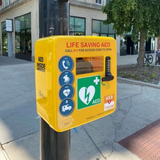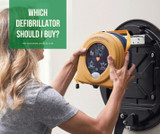Does an AED require maintenance?
An automatic external defibrillator, also known as an AED is used to shock a patient’s heart who has gone into sudden cardiac arrest. A shock, if needed, is delivered in order to encourage the heart to start beating again at it’s natural pace. A sudden cardiac is caused by an electrical fault with the heart which interferes with how it beats which subsequently stops blood being pumped around the body. A person will fall unconscious and need medical assistance urgently.
Thankfully, AEDs have been developed over many years to have a high success rate if used within minutes once someone has fallen ill. Designed for use for both novices and medical professionals alike, defibrillators come with audio and visual prompts to guide you through the entire process, from CPR to placing the electrodes on the chest, you are walked through each stage step by step.
Defibrillators store the medical history of the patient who has been defibrillated so when the paramedics arrive, they are able to see everything that has happened and assess the situation in more detail.
If you have a defibrillator in your place of work, it is important to have a dedicated health and safety team member who is responsible for the defibrillator. This means they would ensure it is free from external damage, it is always fully stocked with equipment such as electrode pads as well as carrying out visual checks.
For defibrillators, electrode pads need replacing on average every two years even if not used. If electrode pads have been used, they must be thrown away and the defibrillator restocked with a new set. You may also need to purchase paediatric pads for children if necessary. AED batteries can have a shelf life of two to five years so it is important to make a note of when you first got your battery so you know when it may need replacing.
Display checks should be carried out at regular intervals such as once a month to ensure the device and it’s components are working correctly. Most defibrillators self test and will alert you if anything is amiss. If a defibrillator fails it’s self test, you should have it looked at as soon as possible.
Annual tests can be carried out by a professional to ensure everything is in working order. Although checking everything over yourself is fine, you may not spot every issue and something could easily be overlooked if the problem isn’t obvious. Professional AED tests are more stringent than the automatic tests that the device performs itself. More in depth tests ensure the defibrillator is working correctly and that it can recognise different heart rhythms, diagnose them correctly and prescribe the next steps to take.
As with anything, defibrillators can deteriorate with age. That’s why it is so important to ensure you check your defibrillator monthly for overall visual checks however, having it serviced annually gives you that additional piece of mind.
At Risk Assessment Products we have a weekly inspection record here
If you are considering a defibrillator and looking into requirements, you may want to have a look at our site assessment form here.
Recent Posts
-
Empowering Communities: The Lifesaving Impact of CPR on Restart a Heart Day
Every year, on and around October 16th, an important event takes place - Restart a Heart Day. This a …16th Oct 2023 -
Which home defibrillator?
80% of all out of hospital cardiac arrests occur at home. Defibrillators are often available in loca …4th Dec 2022 -
Which defibrillator should I buy?
There are many defibrillators available on the market and it can become overwhelming knowing which o …4th Nov 2022




